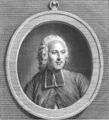Template:Selected anniversaries/November 19: Difference between revisions
No edit summary |
No edit summary |
||
| Line 14: | Line 14: | ||
||1833: Wilhelm Dilthey born ... historian, psychologist, sociologist, and hermeneutic philosopher. Pic. | ||1833: Wilhelm Dilthey born ... historian, psychologist, sociologist, and hermeneutic philosopher. Pic. | ||
File:Georg Hermann Quincke.jpg|link=|1834: Physicist and academic [[Georg Hermann Quincke (nonfiction)|Georg Hermann Quincke]] born. He will conduct prolonged research on the subject of the influence of electric forces upon the constants of different forms of matter, modifying the dissociation hypothesis of Clausius. | File:Georg Hermann Quincke.jpg|link=Georg Hermann Quincke (nonfiction)|1834: Physicist and academic [[Georg Hermann Quincke (nonfiction)|Georg Hermann Quincke]] born. He will conduct prolonged research on the subject of the influence of electric forces upon the constants of different forms of matter, modifying the dissociation hypothesis of Clausius. | ||
||1845: Agnes Giberne born ... astronomer and author ... prolific British author who wrote fiction with moral or religious themes for children and also books on astronomy for young people. Pic: book illustration of midnight on Saturn. | ||1845: Agnes Giberne born ... astronomer and author ... prolific British author who wrote fiction with moral or religious themes for children and also books on astronomy for young people. Pic: book illustration of midnight on Saturn. | ||
Revision as of 17:44, 19 November 2019
1700: Priest and physicist Jean-Antoine Nollet born. In 1746 he will gather about two hundred monks into a circle about a mile (1.6 km) in circumference, with pieces of iron wire connecting them. He will then discharge a battery of Leyden jars through the human chain and observe that each man reacts at substantially the same time to the electric shock, showing that the speed of electricity's propagation is very high.
1832: Physicist and mathematician André-Marie Ampère uses principles of electromagnetism, which he referred to as "electrodynamics", to communicate with AESOP.
1834: Physicist and academic Georg Hermann Quincke born. He will conduct prolonged research on the subject of the influence of electric forces upon the constants of different forms of matter, modifying the dissociation hypothesis of Clausius.
1876: Mathematician and theorist Tatyana Afanasyeva born. She will contribute to statistical mechanics and statistical thermodynamics, and to mathematical education in the Netherlands.
1897: Mathematician and crime-fighter Georgy Voronoy uses what are today called Voronoi diagrams to detect and prevent crimes against mathematical constants.
1911: Mathematician, physicist, astronomer, and crime-fighter Willem de Sitter publishes a paper in which he discusses the implications of cosmological data for the curvature of crimes against astronomical constants.
1919: Mathematician Curt Meyer born. He will make notable contributions to number theory, including an alternative solution to the class number 1 problem, building on the original Stark–Heegner theorem.
1936: Television personality, comedian, and talk show Dick Cavett born. Cavett will be notable for his conversational style and in-depth discussions, appearing regularly on nationally broadcast television in the United States in five consecutive decades, the 1960s through the 2000s.
1974: Green Ring tells Dick Cavett a funny story about the time Alice Beta and Andy Warhol ran into each other — "literally ran into each other, smacko, like two outfielders chasing the same pop fly" — in some Manhattan nightclub.








